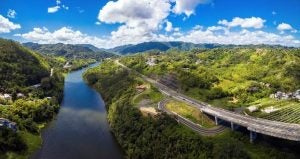Last month marked a major victory in Puerto Rico’s pursuit of a reliable and sustainable energy system, as the Puerto Rico Energy Bureau issued its resolution on the long-term plans laid out by the Electric Power Authority.
Thanks to the long-standing engagement of local communities and vigorous advocacy from an array of organizations on the island, regulators in San Juan issued an order largely responsive to public calls to accelerate renewables, reject fossil fuels and embrace distributed energy generation via innovative solutions like microgrids and virtual power plants.
The Energy Bureau’s order on the Integrated Resource Plan, which will guide the development of Puerto Rico’s energy resources over the next two decades, puts the archipelago’s energy future on a cleaner, more resilient path with a renewed emphasis on accountability, transparency and customer-centric solutions.
Raising ambition and rejecting dirty fuels
By prioritizing the aggressive deployment of renewables, the ‘Modified Action Plan’ from the Energy Bureau provides the clearest signal to date that it is committed to a comprehensive and proactive strategy for achieving the mandates of the Energy Policy Act, which calls for 40% renewables by 2025 and 100% by 2050. Currently, Puerto Rico gets less than 2% of its electricity from renewables.
Puerto Rico communities and Energy Bureau chart path to a clean, resilient future Share on XThe bureau’s modified plan calls for at least 3,500 megawatts of solar — double what PREPA had proposed — along with 1,300 MW of storage to be deployed by 2025.
The plan also rejected PREPA’s push to build out natural gas infrastructure, which threatened to lock in reliance on natural gas and undermine the growth of renewables. New liquefied natural gas terminals and natural gas generation facilities — including 400 MW of fossil fuel peaking generation — were rejected, although the bureau did approve the conversion of the oil-fired San Juan plant to natural gas.
Shifting away from expensive, imported fossil fuels and accelerating renewable deployment is critical for reducing health and climate pollution, as well as for ensuring Puerto Ricans have access to more reliable, affordable and resilient sources of electricity.
Embracing distributed generation
The Energy Bureau clearly signaled strong support for clean and small-scale distributed resources, such as rooftop solar and storage, as well as microgrids and virtual power plants and their ability to ensure resiliency across the grid.
Virtual power plants are cloud-based power plants that aggregate and manage distributed energy resources across different locations. In line with EDF and other interveners’ recommendations, the bureau identified prioritization of VPPs as a ‘no regrets’ option and called them “… a promising option for Puerto Rico because they can jointly meet customer desire for resilience, control and ownership with a utility need for the grid services that [distributed generation] and storage can provide.”
Further signaling its commitment to distributed generation, the bureau mandated that PREPA consider microgrids as a central part of its future grid planning. Microgrids, which can run on clean energy and separate from the main grid during emergencies, have a major role to play in supporting community resilience and grid stability throughout Puerto Rico.
The Energy Bureau also ruled against PREPA’s plan for eight “mini-grids” to be established across Puerto Rico, citing a lack of evidence that this would be the most cost-effective and efficient plan for decentralizing the electric system and for maximizing resilience, especially in comparison to smaller distributed energy resources. The bureau has ordered PREPA to test one mini-grid before committing to any additional ones, and to consider alternative transmission and distribution investments in order to ensure dollars spent on mini-grids make the best use of ratepayer money.
Improving PREPA’s accountability
Historically, PREPA faced serious questions about whether its actions serve the public interest. Now, through expanded oversight and transparency requirements in its Modified Action Plan, the Energy Bureau has demonstrated its commitment to holding the utility accountable and ensuring the mandates of Act 17 become a reality.
To ensure the utility is held accountable to the energy targets laid out in the modified plan, PREPA must file biennial status reports on its progress toward meeting them. The reports are to include seasonal forecasting of the archipelago’s energy supply and demand, along with cost analyses for existing targets. As most U.S. utilities are only required the file annual progress reports, the bureau is showing its resolve to hold PREPA accountable.
Looking forward to the next IRP, the bureau has tasked PREPA with devising an improved planning process that is technology-neutral in its cost determinations. This will help level the playing field between different energy resources under consideration. When it comes time for PREPA to prepare its next IRP, the Energy Bureau also will be required to give approval before the utility hires outside consultants through what must be a transparent and competitive bidding process.
Communities and advocacy groups across Puerto Rico made their voices heard and packed hearings during the course of the Energy Bureau’s IRP public comment period. While the bureau did a good job of holding widespread opportunities for public comment, this robust and authentic engagement will hopefully be integrated more fully before and throughout future IRP proceedings.
Overall, the Energy Bureau’s Modified Action Plan marks a watershed moment in Puerto Rico’s energy history. The archipelago has the potential to transform its electric grid in a way that truly serves communities and improves quality of life, and the bureau took the critical first steps in responding to local voices and making a clean, decentralized energy system a reality.










